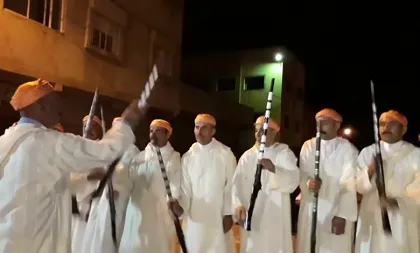Moroccan Tbourida: The term “Tbourida” refers to a traditional Moroccan equestrian performance that originated in the North African country. It is also known as “Fantasia” in different regions of Morocco. Tbourida is an essential part of Moroccan cultural heritage and is often performed at festivals, weddings, and other celebratory events.

The primary instrument used in taborida is the tabor, a small drum played with a stick called “naqos” or “naqus.” The tabor is typically made of wood with goat or sheepskin stretched over one end. The player holds the tabor under one arm and strikes it with the stick to create rhythmic patterns.
The rhythm of the taborida is vibrant and dynamic, with a strong focus on percussion. The dancers, typically men, form a circle or line and move in harmony with the music. They often wear traditional attire, such as djellabas (long robes) and fez hats, enhancing the visual spectacle of the performance.
Taborida is characterized by its fast rhythm, lively drumming, and intricate footwork. Dancers use a variety of steps, such as spins, kicks, and quick foot shuffles, to synchronize with the energetic beats of the tabor. The dance can be quite acrobatic, with performers executing jumps and leaps to showcase their skill and agility.
Alongside the tabor, other instruments might accompany the taborida performance, such as the bendir (a large frame drum), the naqqara (small kettledrums), and occasionally stringed instruments like the oud or the guembri.
Taborida is not only a form of entertainment but also serves as a cultural expression and a way to celebrate Moroccan heritage. It is deeply rooted in the traditions and customs of various regions in Morocco and continues to be practiced and appreciated today.
Tbourida taza galdmen by video:
Moroccan Tbourida season
The Moroccan Tbourida season marks the time when Tbourida, also known as Fantasia, is prominently performed and celebrated in Morocco. This traditional equestrian display highlights the skill and coordination of Moroccan horsemen. It is a vital cultural event occurring year-round, with heightened popularity during specific seasons and festivals.
One of the most notable times for Tbourida is during the Moussem of Sidi Mohammed Ben Abdellah in Meknes, held annually in May. This event draws Tbourida troupes from across Morocco to compete and showcase their horsemanship, attracting large crowds of locals and tourists eager to witness the captivating performances.
Another key season for Tbourida is Eid al-Adha, the Feast of Sacrifice, a major Islamic festival celebrated globally. During Eid al-Adha, Tbourida performances are common in various Moroccan cities and towns, enhancing the festive holiday atmosphere.
In addition, Tbourida is featured during national holidays, cultural festivals, and special events throughout the year, offering troupes the chance to exhibit their talents and entertain audiences.
While Tbourida has its peak seasons, it can be enjoyed and performed at other times as well. Its tradition holds deep significance in Moroccan culture, with performances cherished year-round.

